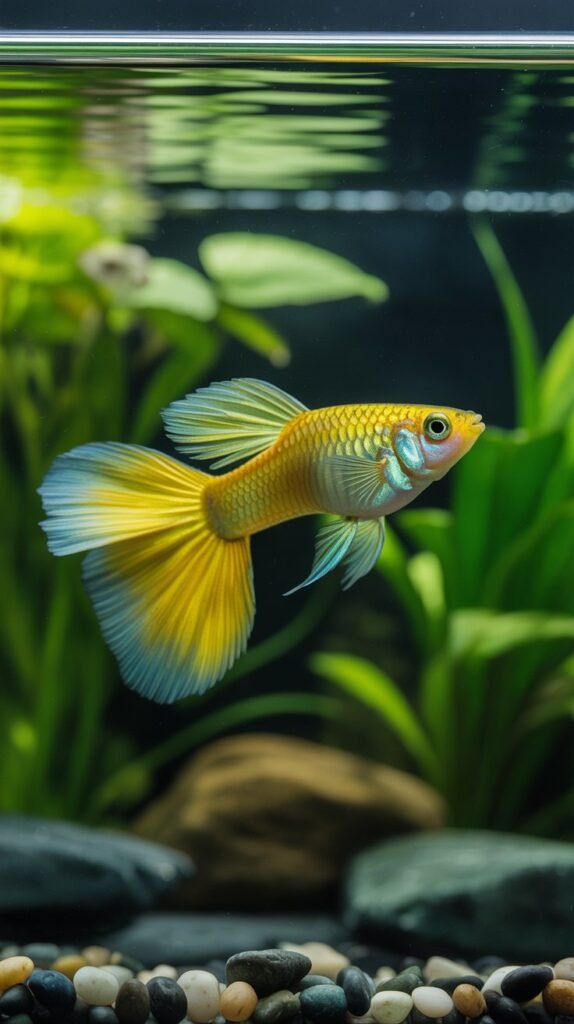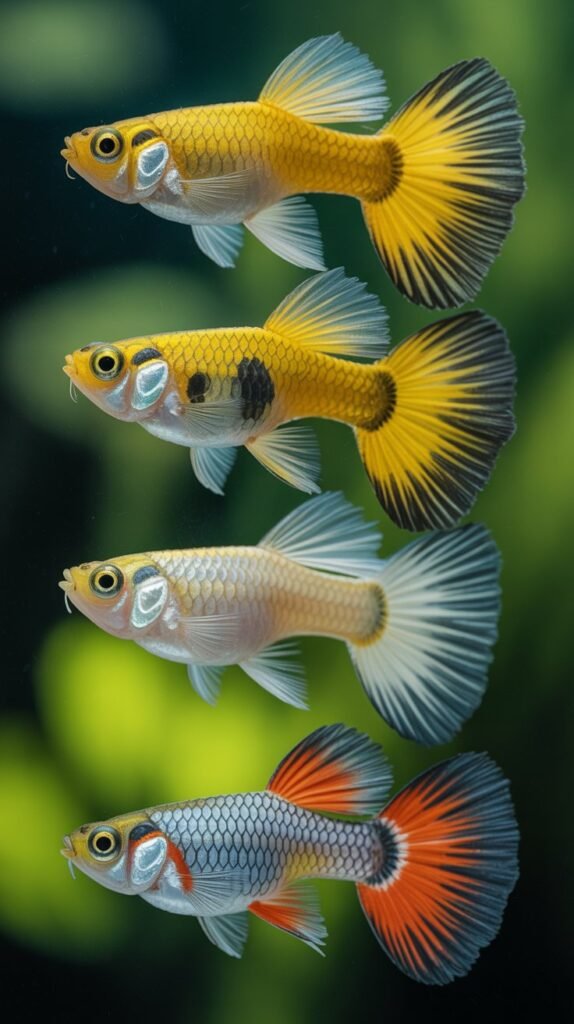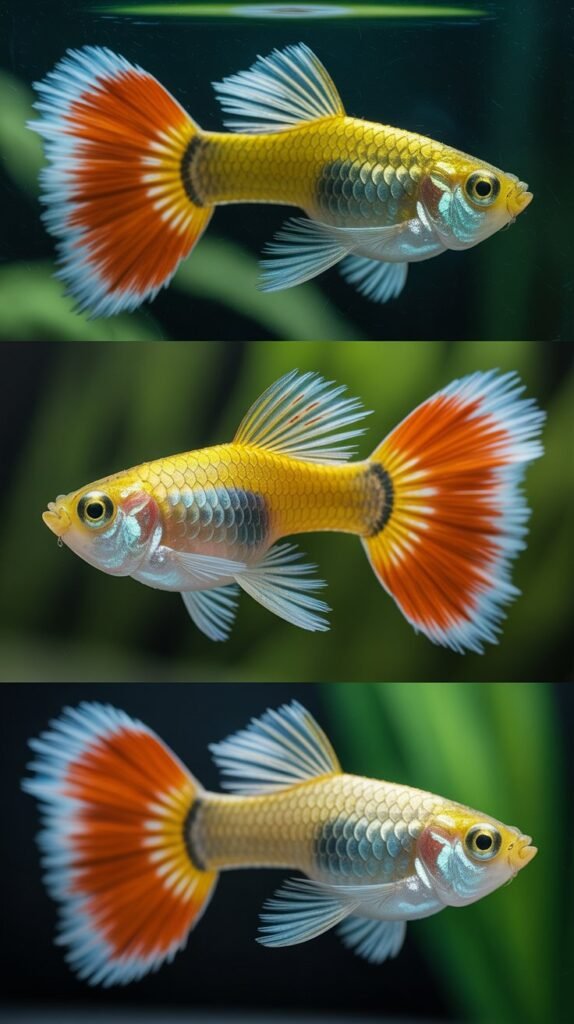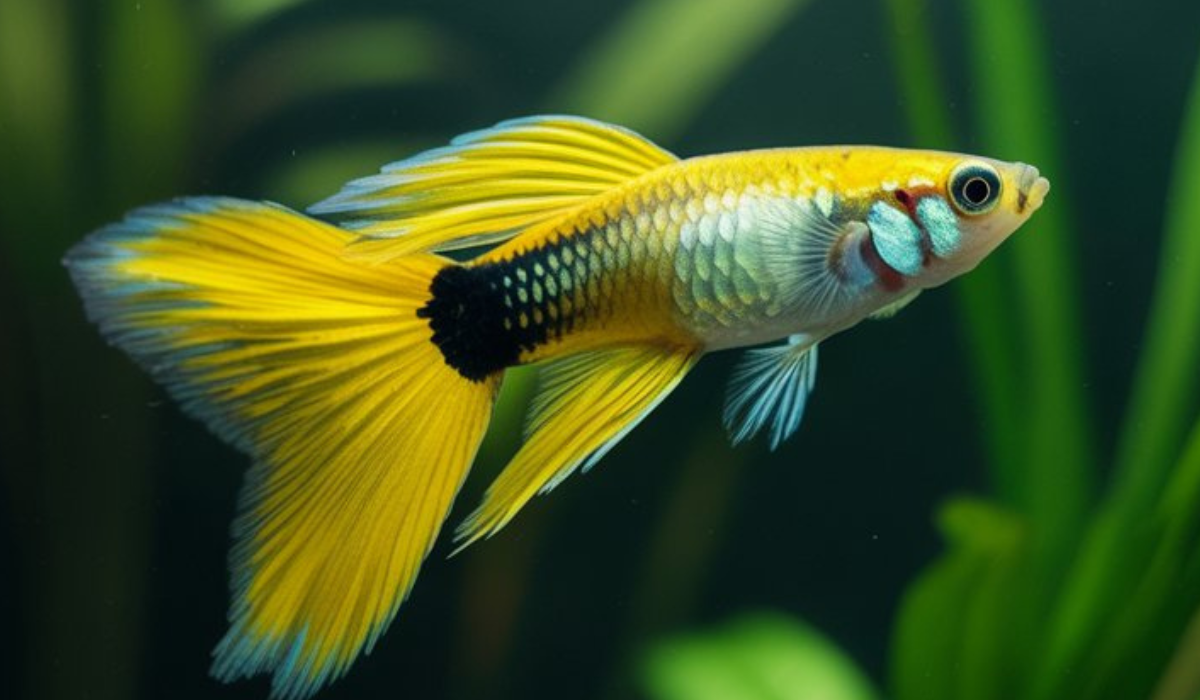The Yellow Delta Guppy is one of the most stunning and graceful guppy varieties, admired for its radiant yellow tail and elegant delta-shaped fin. Known for its peaceful temperament, hardy nature, and eye-catching coloration, this guppy is a favorite among both beginner and experienced aquarists.
In this comprehensive guide, you’ll learn everything about the Yellow Delta Guppy — from its origin and appearance to care requirements, breeding, tank setup, and feeding tips. Whether you’re planning to add them to your aquarium or breed them for profit, this guide will help you create a thriving environment for your guppies.
What Is a Yellow Delta Guppy?
The Yellow Delta Guppy is a selectively bred variety of Poecilia reticulata, one of the most popular freshwater fish species in the aquarium hobby. Its name comes from its vivid yellow coloration and delta-shaped (triangular) tail fin, resembling the Greek letter Δ (delta).
These guppies are known for:
- Bright yellow or golden tail and dorsal fins
- Metallic or silver-blue body tones
- Graceful movements and active swimming
- Peaceful behavior and social nature
Because of their dazzling appearance and hardy genetics, they are commonly found in aquariums worldwide and are perfect for community tanks.
Origin and Background

Guppies are native to South America, particularly regions in Venezuela, Brazil, Trinidad, and Guyana. Over decades, breeders across the world have developed countless color and tail variants — including the Yellow Delta Guppy.
The delta tail shape emerged through selective breeding, emphasizing wide, triangular fins that flare beautifully when the fish swims. The yellow coloration was developed through generations of careful selection, resulting in a vibrant, uniform hue that glows under aquarium lighting.
Appearance and Physical Characteristics
The Yellow Delta Guppy stands out because of its spectacular tail and glowing body coloration.
1. Body Shape
Like other guppies, they have a slender, torpedo-shaped body designed for quick and smooth movement.
2. Coloration
Their tail fin displays a bright yellow hue that can vary from soft lemon tones to deep golden shades. Some specimens also show iridescent blue or green scales on their bodies.
3. Tail Type
The delta tail is wide and triangular, spreading out gracefully like a fan. It adds elegance and makes them highly visible in aquariums.
4. Size
- Male Yellow Delta Guppy: 1.2 to 1.6 inches (3–4 cm)
- Female Yellow Delta Guppy: 2.0 to 2.4 inches (5–6 cm)
5. Lifespan
With proper care, they live for 2 to 3 years, though some can live up to 4 years in ideal conditions.
Male vs Female Yellow Delta Guppy
It’s easy to tell male and female guppies apart, even in the Yellow Delta variety.
| Feature | Male | Female |
|---|---|---|
| Size | Smaller | Larger |
| Color | Brighter yellow with vivid tail | Pale or duller |
| Tail Shape | Larger, more pronounced delta tail | Shorter, rounded tail |
| Body Shape | Slender | Plump, rounded |
| Gonopodium | Present (used for mating) | Absent |
Males are more colorful and active, while females are larger and less vibrant but crucial for breeding programs.
Behavior and Temperament
The Yellow Delta Guppy is peaceful, social, and playful. They thrive in groups and rarely show aggression, making them perfect for community aquariums.
Behavior Traits:
- Constantly swimming in the mid to upper water column
- Males often display courtship dances around females
- Love exploring plants and decorations
- Active during the day and rest at night
They get along well with most small, non-aggressive fish species, making them ideal tank mates.
Tank Requirements for Yellow Delta Guppies

Providing a well-maintained and comfortable environment is key to keeping your Yellow Delta Guppies healthy and happy.
1. Tank Size
A minimum 10-gallon tank is recommended for a small group (3–5 guppies). However, a 20-gallon tank is better if you plan to keep multiple males and females or add other species.
2. Water Conditions
| Parameter | Ideal Range |
|---|---|
| Temperature | 72–82°F (22–28°C) |
| pH Level | 6.8–7.8 |
| Hardness | 8–12 dGH |
| Ammonia/Nitrite | 0 ppm |
| Nitrate | <20 ppm |
Stable water parameters are crucial. Always use a heater, filter, and thermometer to maintain consistency.
3. Filtration
A gentle sponge or hang-on-back filter works best. Avoid strong water currents that may damage their delicate tails.
4. Lighting
Use moderate LED lighting to enhance their yellow hues. Too much brightness can stress them, so balance is key.
5. Substrate and Decor
- Fine gravel or sand substrate
- Live or artificial plants (Anubias, Java fern, Hornwort)
- Driftwood or rocks for decoration
- Floating plants to provide shade
Tank Mates for Yellow Delta Guppies
Yellow Delta Guppies are community-friendly and get along with other peaceful species.
Ideal Tank Mates:
- Neon Tetras
- Mollies
- Platies
- Endler’s Livebearers
- Zebra Danios
- Corydoras Catfish
- Cherry Shrimp
Avoid Aggressive Fish:
- Bettas (especially males)
- Barbs
- Cichlids
- Large gouramis
Always observe new tank additions for compatibility.
Diet and Feeding
Yellow Delta Guppies are omnivorous and will eat almost anything offered, but a balanced diet ensures vibrant color and good health.
1. Staple Diet:
- High-quality flake food or micro pellets
- Spirulina-based foods to enhance yellow coloration
2. Protein Sources:
- Brine shrimp
- Daphnia
- Bloodworms
- Micro worms
3. Vegetables:
- Blanched spinach
- Cucumber slices
- Zucchini
Feed small amounts 2–3 times daily. Avoid overfeeding to prevent water pollution.
Breeding Yellow Delta Guppies

Breeding these guppies is easy and rewarding. Like all guppies, they are livebearers, meaning females give birth to free-swimming fry instead of laying eggs.
1. Breeding Setup
- Use a separate 10–15 gallon breeding tank
- Maintain water temperature around 78–80°F
- Add dense plants (Java moss or floating plants) for fry to hide
2. Male to Female Ratio
Keep a 1:2 or 1:3 ratio (1 male per 2–3 females). This prevents stress on females caused by persistent males.
3. Courtship and Mating
Males display their fins and chase females. Once mating occurs, the female stores sperm and can give birth multiple times without further mating.
4. Gestation Period
- Around 25–30 days
- Females develop a dark gravid spot near the anal fin
5. Fry Care
- Fry are born fully formed and swim immediately
- Feed crushed flakes, baby brine shrimp, or infusoria
- Separate adults to prevent them from eating fry
Within 3–4 months, fry reach adulthood and begin showing their yellow coloration.
Common Diseases and Prevention
Even though Yellow Delta Guppies are hardy, poor water conditions or diet can lead to illnesses.
1. Ich (White Spot Disease)
- Symptoms: White spots on fins and body, scratching on surfaces
- Treatment: Raise temperature gradually and treat with ich medication
2. Fin Rot
- Symptoms: Torn, frayed fins
- Causes: Poor water quality or bacterial infection
- Treatment: Use antibacterial medication and maintain clean water
3. Velvet Disease
- Symptoms: Yellowish dust on skin, clamped fins
- Treatment: Dim lights, increase temperature, use copper-based treatments
4. Swim Bladder Disorder
- Symptoms: Difficulty swimming upright
- Prevention: Avoid overfeeding and provide a balanced diet
5. Fungal Infections
- Symptoms: Cotton-like patches on fins or body
- Treatment: Use antifungal aquarium medication
Prevention Tips:
- Regular water changes (25–30% weekly)
- Avoid overcrowding
- Quarantine new fish
- Provide varied nutrition
Enhancing the Color of Yellow Delta Guppies
For more intense and vibrant yellow coloration:
- Use color-enhancing foods with carotenoids and spirulina
- Maintain stable temperature and clean water
- Use black or dark backgrounds to make colors pop
- Provide balanced lighting for 8–10 hours daily
Healthy fish always display richer colors!
Lifespan and Care Tips
On average, a Yellow Delta Guppy lives for 2–3 years. To extend their lifespan:
- Keep stable water parameters
- Feed a varied and nutritious diet
- Perform regular tank maintenance
- Avoid sudden temperature changes
- Provide a stress-free environment
With good care, they can even live beyond 4 years in captivity.
Why Choose Yellow Delta Guppies?
There are several reasons aquarists love this guppy variety:
✅ Beautiful Coloration: Bright yellow fins glow under aquarium light.
✅ Peaceful Nature: Ideal for community tanks.
✅ Easy to Breed: Great for hobby breeders.
✅ Low Maintenance: Perfect for beginners.
✅ Affordable and Available: Common in most pet stores.
Their cheerful color and graceful tail make them a centerpiece in any aquarium setup.
Aquascaping Ideas for Yellow Delta Guppies
Since their yellow fins are so striking, the right aquascape enhances their visual appeal.
1. Plant Selection
Use green plants like:
- Java Fern
- Amazon Sword
- Anubias
- Hornwort
- Water Wisteria
These create a beautiful color contrast with the guppy’s yellow tail.
2. Background
A dark or black background makes their color stand out dramatically.
3. Substrate
Fine sand or dark gravel complements their brightness.
4. Lighting
Soft white or daylight LED lighting works best to highlight their vivid tones.
Price and Availability
Yellow Delta Guppies are widely available in pet stores and online.
- Price Range: $2 – $6 per fish (depending on quality and fin size)
- Pairs or Trios: Often sold as 1 male + 2 females
You can also find high-grade show guppies from specialized breeders for $10 or more per fish.
Tips for Beginners
If you’re new to guppies or aquariums:
- Start with a 10–20 gallon tank.
- Use a quality water conditioner and filter.
- Cycle your aquarium before adding fish.
- Maintain consistent temperature and water quality.
- Feed a balanced diet and observe your fish daily.
Yellow Delta Guppies are one of the best beginner-friendly fish to start your aquarium journey.
Conclusion
The Yellow Delta Guppy is a brilliant blend of beauty, elegance, and simplicity. With its radiant yellow fins and flowing delta tail, this guppy brings color and life to any aquarium. Its peaceful nature, ease of breeding, and adaptability make it perfect for both beginners and seasoned aquarists.
By providing proper water quality, a balanced diet, and a suitable tank environment, your Yellow Delta Guppies will thrive, reproduce, and display their best coloration year-round. Whether for enjoyment, breeding, or aquascaping, these fish are a truly rewarding addition to your aquarium.
FAQs About Yellow Delta Guppies
Q1: What is the ideal temperature for Yellow Delta Guppies?
A: The best temperature range is 72–82°F (22–28°C) for healthy growth and coloration.
Q2: How long do Yellow Delta Guppies live?
A: With good care, they live 2–3 years, sometimes up to 4 years.
Q3: Can Yellow Delta Guppies live with other guppy varieties?
A: Yes, they can. However, interbreeding may occur, leading to mixed colors in offspring.
Q4: How often should I feed them?
A: Feed 2–3 small meals per day. Avoid overfeeding to prevent water quality issues.
Q5: How do I tell male and female Yellow Delta Guppies apart?
A: Males are smaller, more colorful, and have a gonopodium; females are larger and duller in color.
Q6: Do Yellow Delta Guppies need a heater?
A: Yes, especially if your room temperature drops below 72°F.
Q7: Are Yellow Delta Guppies suitable for beginners?
A: Absolutely! They’re hardy, peaceful, and easy to care for — ideal for new aquarists.
Q8: How can I enhance the yellow color of my guppies?
A: Feed color-enhancing foods like spirulina flakes, maintain clean water, and use balanced lighting.
Q9: Do guppies eat their babies?
A: Yes, adult guppies may eat fry. Provide hiding spots or separate the fry in a breeder tank.
Q10: How many guppies should I keep together?
A: Keep them in groups of at least 5–6 for social comfort. Maintain a 1:2 male-to-female ratio.

